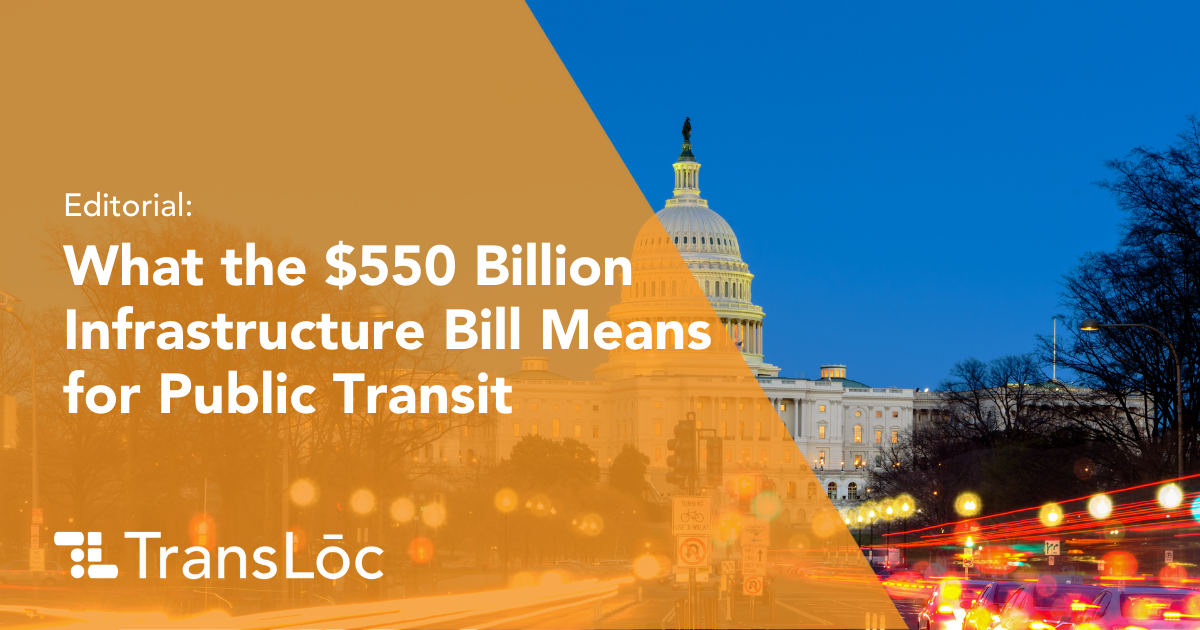
The Senate has passed the largest ever federal investment in public transit: a $550 billion infrastructure package that improves transportation, internet and water/power systems to “grow the economy, enhance competitiveness, create good jobs and make our economy more sustainable and resilient.”
Notably, the bill includes $39 billion in public transit funding, which will fund maintenance, replacement and expansion projects, enhance transit systems for elderly and disabled, and reduce carbon emission.
And the timing — post-pandemic as we work to revitalize America — has never been more critical to ensure the future of public transit.
According to results from a public transit survey we’re releasing at the end of this month, public transit riders say public transit is more important than ever when it comes to getting Americans back to work and re-connecting communities post-pandemic:
- Public transit was the most used transportation method before the pandemic (46%) and it will remain as such post-pandemic (36%).
- Most Americans who regularly used public transit before the pandemic plan to use it just as frequently once their areas have reopened (72%).
We’re hopeful that this package will bring much needed funding to our transit systems as we work to rebuild our communities, and within the $39 billion public transit funding, here are the areas we’re watching closely to support future transportation planning and design:
The State of Good Repair – $4.75 billion:
“Supports maintenance, replacement and rehabilitation projects. This will help transit agencies maintain assets in a state of good repair and develop Transit Asset Management plans.” – Politico
- While the majority of funding will be spent purely repairing outdated systems, public transit riders we surveyed revealed that the top improvements they want to see are new apps or transit technology that make the rider experience better (74%) and new safety protocols that keep vehicles clean (73%) and prevent overcrowding (73%).
- We’re committed to creating transportation planning and design strategies that help transit agencies make needed improvements to systems that support more accessible, safer public transit access for all communities.
The Capital Investment Grants Program – $8 billion:
“Supports new and expanded commuter and light rail, bus and ferry service. The program includes New Starts for the construction of new systems and expansion of existing systems. Small starts for new systems and expansion projects with capital costs less than $300 million, Core Capacity for projects related to corridor development and projects with combined system goals.” – Politico
- Our data shows that commuting is difficult for Americans as 2 in 5 public transit riders (39%) use two forms of transportation to get to work and another 1 in 5 (20%) use three forms of transportation.
- By expanding commuter services, adding systems and enhancing transit technology, we give American riders more flexibility and options to efficiently commute to and from work and stay connected to our communities.
Mobility Enhancements for Seniors and Disabilities – $2 billion:
“Makes federal resources available to improve mobility for seniors and individuals with disabilities by removing barriers to transportation service and expanding transportation mobility options. Supports transportation in all areas: large urbanized, small urbanized and rural.” – Politico
- More than 223 million unlinked passenger trips using Paratransit services are recorded each year, serving tens of millions of riders in the United States alone. In fact, more riders with disabilities (42%) use the bus three or more days per week than do the nondisabled (28%). One in 5 people age 65+ don’t drive, whether for physical/health or financial reasons. With higher percentages of seniors living in rural/suburban areas, public transit isn’t an option for many. Nor are rideshares/taxis due to cost or availability.
- To solve this issue, we know that on-demand service is actually more efficient than mass transit programs for many parts of the country, including services that cater to seniors and those with disabilities. Many municipalities don’t have busy thoroughfares, and are wasting money on dedicated bus lines when an on-demand service option could save them money and better serve their citizens.
- We’re committed to helping agencies implement new transit technology that puts microtransit systems in place, where people can call by phone or use an app to order vehicles that pick them up at their door and take them where they want to go.
Low-No Program – $5.25 billion:
“Provides funding to state and local governments for the purchase or lease of zero-emission and low-emission transit buses, including acquisition, construction and leasing of required supporting facilities.” – Politico
- Transit riders in 2021 care about sustainability, and they want transit agencies to prioritize upgrading systems to be more environmentally friendly. Our data shows that within the next year, roughly half of transit riders think their local transit agencies should implement more sustainable practices (52%) and invest in electric vehicles (EVs) (45%).
- Cities have rightly recognized the need to better accommodate electric and eventually autonomous fleets, and many are actively planning for how to update both infrastructure and local regulation to meet this new future.
We’re well positioned to help agencies prepare for this by simulating a range of microtransit scenarios with electric vehicles of varying size and range to aid in vehicle purchasing, planning, and operational decisions which are vital to successful microtransit services. Deciding whether to purchase a smaller fleet of large, longer-range vehicles or multiple smaller, shorter-range vehicles is an essential component of building a successful and cost-effective electric powered microtransit service.